Two sims for one
Overview of the communicator, which can work with two SIM-cards at once.
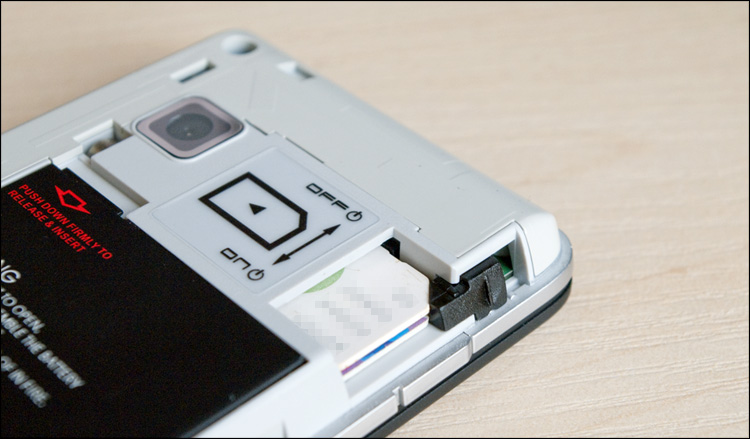
Few people know that the well-known company Gigabyte has a unit engaged in the development and creation of communicators - all this is called GSmart. Once I already wrote about one of their “pipes”, but relatively recently, at one of the company's conferences, in the literal sense of the word “handing out” new items. I decided to write about one of the models, because Unlike hundreds and thousands of other devices, it differs in one nuance - inside, engineers have provided space for two SIM-cards at once. Immediately I will warn you that the model works on the basis of Windows Mobile 6.5 OS, but ... but you also wonder how the two sims work in the device at once? ) Otherwise, the model has a lot in common with the communicator, about which I have already written, so I will not particularly repeat (in particular, about the interface).
')
So, the model is called Gigabyte GSmart S1205 Cougar or simply GSmart S1205. Not the most “even” index of the model, so it was easier for me to remember the word “Cougar” - it was with the modeling of the same-name car (Ford Cougar) that I once started to learn 3D Studio Max.

A few words about the device. It was built on a processor that was not distributed among communicators - MediaTek MT6516 with a clock frequency of 416 MHz. Memory capacity (RAM) - 128 MB (74 MB available), built-in flash memory (ROM) - 256 MB (126 MB available). Of the communication capabilities - work in the tri-band GSM (900/1800/1900 MHz), support for GPRS / EDGE, Bluetooth modules (2.0 + EDR), Wi-Fi (802.11b / g) and GPS (with aGPS support). There is a slot for microSD cards (up to 16GB), and interaction with a computer is via a microUSB-connector. All this lies in a fairly compact package - dimensions are 55x111x13 mm, and weight - 115 g.
The device is sold in a compact white packaging, inside which is another, but already black. The dimensions seem to hint that it is not worth waiting for a large number of “buns”.


And rightly - inside, in addition to the phone, there is a wired stereo headset, a charger (with a removable plug), a USB-microUSB wire, a battery, a non-personalized MegaFon SIM card and a stylus with a brief guide. Everything is standard - it is strange that there is no microSD card with some pre-installed, for example, navigation software.
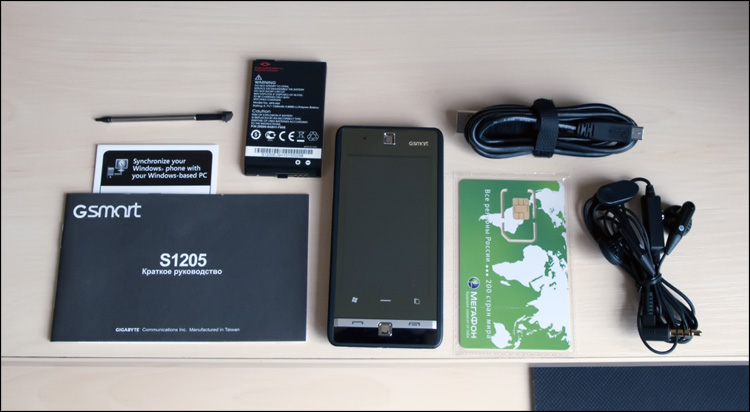
The stylus is telescopic and a space is provided for it in the device case ... but it is not so necessary - the device screen does not have a relief frame, so even with a finger it will be easy to get into the corner of the screen. The battery is lithium-polymer for 1320 mAh (3.7V, 4.88Wh). And about Sims - as far as I know, through it you can only go online, and since I did not need it, I decided not to unpack it.
In appearance - the most common communicator. A large screen (almost the entire front side), a pair of buttons below them .... There is nothing that distinguishes this device from many others. Therefore, I will describe what is) Above the large screen (3.2 inches, resolution 240x400) there is an average loudspeaker in volume, and under it are two touch buttons (not occupying the active part of the display) and three normal buttons (green from the red tube and “ok”) . The first touch button calls "Start", and the second one is more useful - it allows you to adjust the parameters of both SIM cards with one touch.
On the left there are two buttons for volume control and a hole for a lace (strangely, they are not drilled in many new devices), on the right there is an unprotected memory card slot and a camera button. The buttons are quite recessed - they just won't click.


At the top - only the power button, and at the bottom - microUSB and minijack (for headphones), a hole for the stylus and the "point" of the microphone.
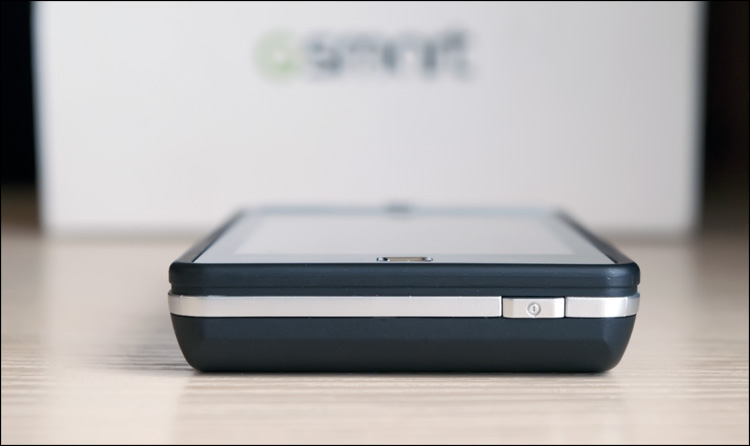
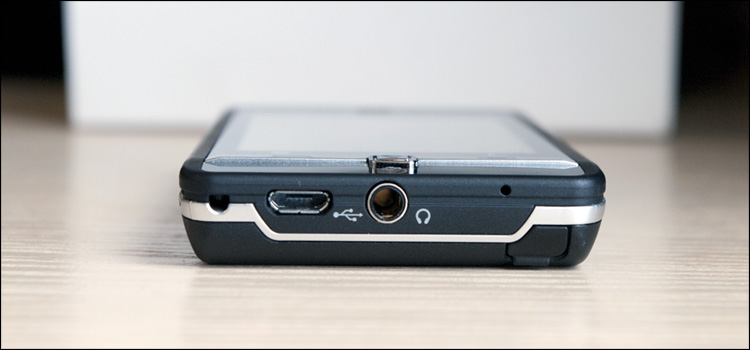
On the back side, absolutely nothing but a peephole of a 3 megapixel camera. The case (in particular, the back cover and all sides around the perimeter) are made of soft-touch velvety material - it is almost unmarked and, unlike chrome inserts, should not peel off. But the front side ... a little squeaks when pressed hard, but even if you just touch - there are prints.
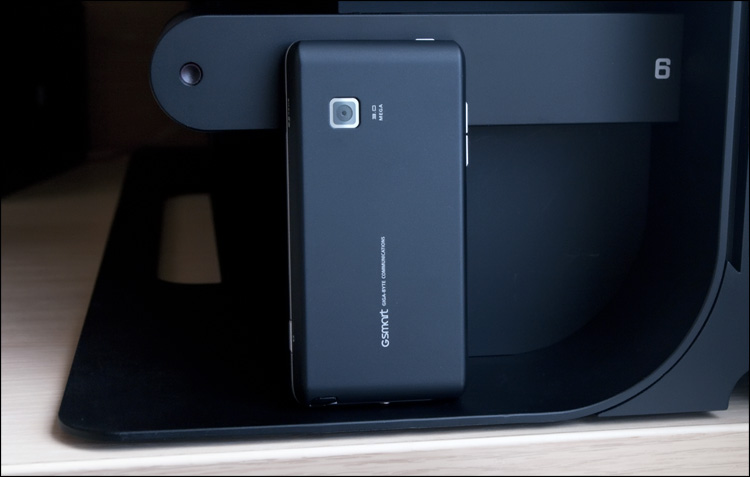
As for SIM-cards, they are inserted one above the other in an almost imperceptible slot, which cannot be blocked by anything (except for the cover) - accordingly, the operators can be changed without removing the battery. For reliability, sims are blocked by a special slider (as in the photo before kata). I climbed in my pockets, scratched in the bottom of the barrel, pomelo on barns ... I barely found two SIM cards with numbers I knew and a non-zero balance. I insert and press "on".

Until fully operational, the communicator turns on in 30 seconds. More precisely, the first Ra failed to measure time - the phone asked to enter a PIN code from one of the SIMs.
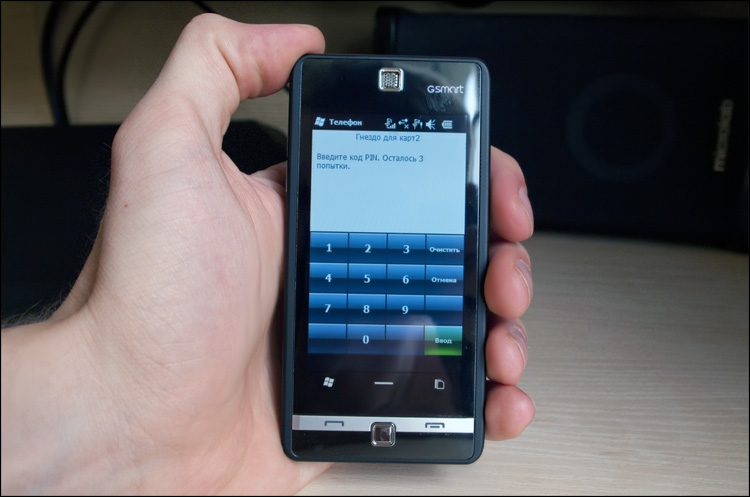
The appearance of the desktop and interface (called Gigabyte GSmart Touch) is generally very similar to the standard WM-shell, but with minor modifications, mainly related to finger optimization, I wrote about it in detail in the previous review. Although no, something almost immediately catches the eye - there is no usual “tray” with icons, and in its place there are two large antenna icons. And below are two such signatures, saying Megafon and MTS.

In addition to the start, pressing the center button brings up three working screens, which you can successively switch with your finger, all applications are dumped there. A similar organization of icons is used a lot of where, in the same iPhone or Samsung Jet, about which I also wrote.
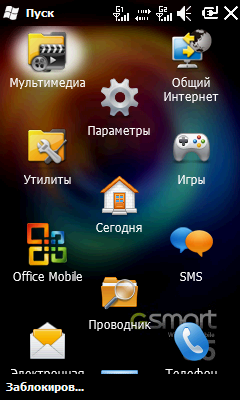



I take my home phone and try to call one of the numbers - everything works. I drop and call the second SIM card - it works too. Well, that's nice) Now we need to figure out how to call with all this design.
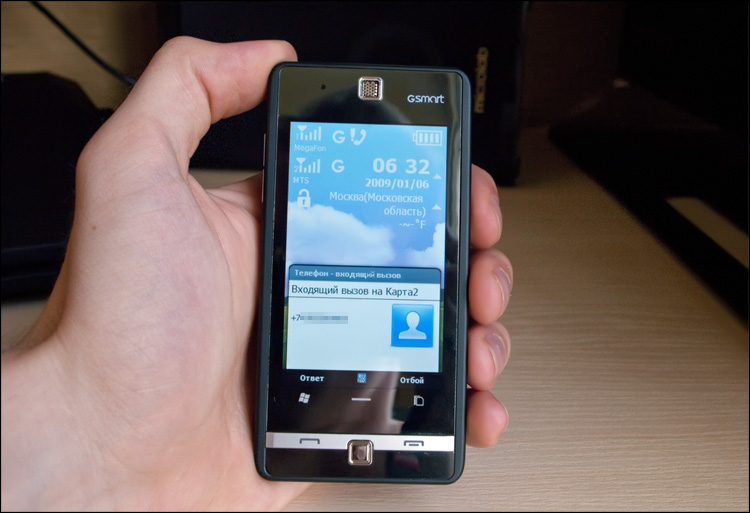
And in this regard, everything is simple - after pressing the "green button" a standard dialer appears, but it already has two buttons "call". I try to press both - that's right, calls from both numbers, and the main problem is to remember which of the sims from which operator. And this is a matter of time, partly dependent on the memory leaky. Access to the Internet and sending messages occurs only from the Namba Van SIM card, and in order to change their places, you will have to select the Network Router every time you start, in which you specify which of the SIMs is more important.
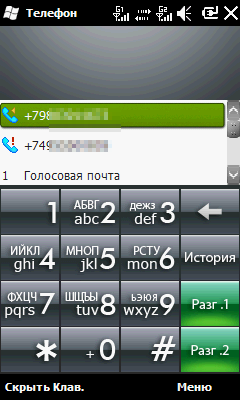

The right touch button (under the screen) invokes the SIM card settings menu - in fact, this is the most usual service menu. For each card, you can configure certain services and more everyday things - the type of call (melody, vibro, etc.), the mode of operation (or non-work, hehe). And in the “start” menu now not one SIM-menu, but two.
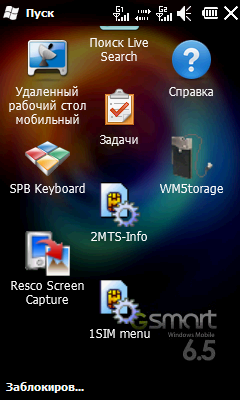

The interface for setting the alarm clock, displaying the battery status and managing the wireless interfaces has been slightly redesigned - it’s more convenient, you won’t miss it with your finger.
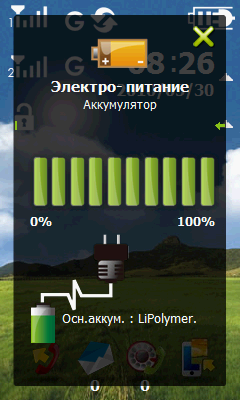
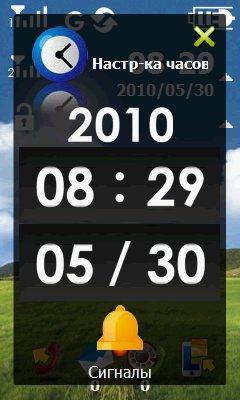
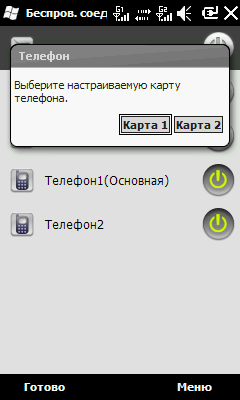
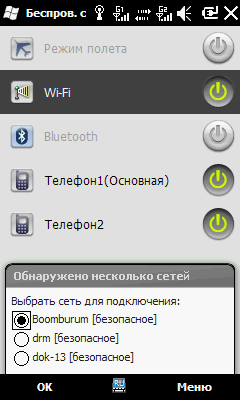
The speaker is quite good in terms of sound quality, but quiet. I did not even try the headset, because there is not much to expect. But the other headphones stuck - they are great for the headset, so earned built-in fm-radio.
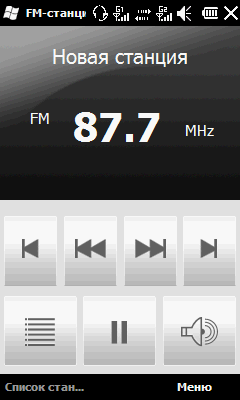
The camera is there, but she was not impressed. Called through a start or hardware button, the button itself is the frame. The focus is induced quickly, something seems to be clicking ... but the photos in quality (sharpness, color reproduction and noise) are lagging behind what analogs are now offering. And the camera interface is not the most convenient - small buttons scattered around the perimeter of the screen.

Sample camera photos:


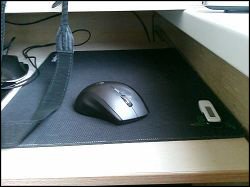






The operating time was pleasantly surprised, despite the fact that batteries of the same capacity are now put almost everywhere. Judging by the test with IXBT, it is able to work 2.5 days in the mode of playing music (with the screen off) or 7 hours in GPS mode! Unfortunately, I can’t physically afford to check these numbers, but I believe - for the entire time of the tests, it has been charged only once and for propriety.
 Supported work with two SIM-cards
Supported work with two SIM-cards
 There is a hole for the lace) Well, now it is a rarity;
There is a hole for the lace) Well, now it is a rarity;
 Long battery life;
Long battery life;
 Large screen, memory card slot;
Large screen, memory card slot;
 Good performance;
Good performance;
 Adequate price;
Adequate price;
 No support for 3G networks;
No support for 3G networks;
 Poor equipment - no memory card, no cover, no mount in the car ... a pity;
Poor equipment - no memory card, no cover, no mount in the car ... a pity;
 Not the most responsive screen - at least after the capacitive display was quite uncomfortable;
Not the most responsive screen - at least after the capacitive display was quite uncomfortable;
 The camera does not have a flash, and the quality of the photos is very mediocre;
The camera does not have a flash, and the quality of the photos is very mediocre;
I didn’t attribute Windows Mobile operating system to either minuses or pluses - let everyone decide for himself)
The price is 11-12 thousand rubles. It is more expensive than frankly Chinese crafts for two simok, but unlike them, GSmart really works and is supported by the manufacturer. Is it a lot or a little? I agree that for this money you can buy a good phone from a better-known manufacturer - the market is huge. But how many of them are capable of simultaneously in two networks? So you don’t have to choose much.
* UPD * In the Yandex Market, I looked at which of the communicators are friends with two operators at once - only 4 models were found. In addition to GSmart, this is either an unknown Sitronics SDC-106, or the expensive Acer Tempo DX900 and Eten Glofiish DX900.

Communicator can be safely recommended to those who are not afraid of Windows Mobile and those who want to be able to be connected to two operators at once. Agree that keeping one handset in your pocket and being available at the same time by two numbers is not at all the same thing as keeping the second SIM card under the cover and periodically pulling out the battery to change their places. During the time that I tested the device, I even became attached to this “feature” - I use Megaphone myself, but I have a lot of friends on the MTS. I did not calculate the savings, but the calls in my network are cheaper, so the savings can be really economical.
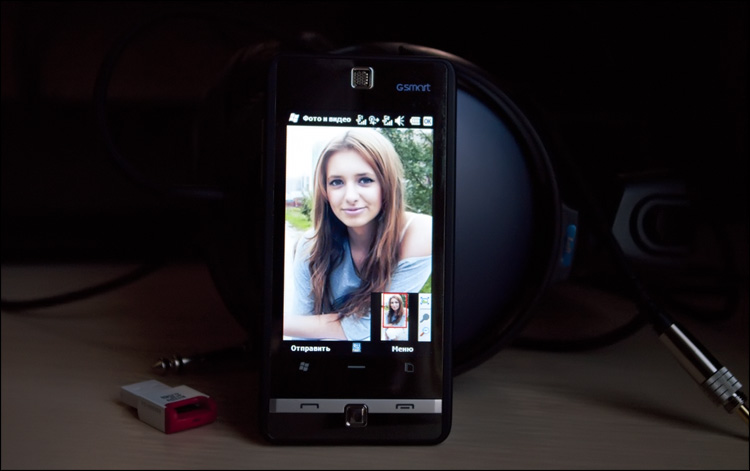
Otherwise, this is ANOTHER device for a platform that is slowly surrendering to its position. Good performance, a very reliable and convenient case, a good software tool out of the box ... but I didn’t find anything outstanding (except for a long time battery life). So, for example, just for the sake of two SIM cards, I wouldn’t have moved from the HTC HD2 I love, which I have been using for half a year and it’s still like new. Therefore, you need to decide for yourself what is more important - checkers or go. Although I would not have refused to be able to be connected in two networks at once - in my current scenario, the money in the account literally conceals.
By the way, together with the GSmart S1205 model, the GIGABYTE company then announced another device, but already based on the Android OS - GSmart G1305 Codfish . It works in four GSM-bands, supports HSDPA (900/1900/2100 MHz), has on-board Wi-Fi, Bluetooth and GPS modules. The remaining specifications are a 3.2-inch screen (320x480), 256MB RAM and ROM, a slot for microSD cards, a 5 megapixel camera and a Qualcomm MSM7227 processor with a clock frequency of 600 MHz.
Well, and more. At that meeting I had the opportunity to meet Anatoly Wasserman - a very interesting person! :) I will try to invite to the site - fiercely plus for invites)

Successes!

Few people know that the well-known company Gigabyte has a unit engaged in the development and creation of communicators - all this is called GSmart. Once I already wrote about one of their “pipes”, but relatively recently, at one of the company's conferences, in the literal sense of the word “handing out” new items. I decided to write about one of the models, because Unlike hundreds and thousands of other devices, it differs in one nuance - inside, engineers have provided space for two SIM-cards at once. Immediately I will warn you that the model works on the basis of Windows Mobile 6.5 OS, but ... but you also wonder how the two sims work in the device at once? ) Otherwise, the model has a lot in common with the communicator, about which I have already written, so I will not particularly repeat (in particular, about the interface).
')
So, the model is called Gigabyte GSmart S1205 Cougar or simply GSmart S1205. Not the most “even” index of the model, so it was easier for me to remember the word “Cougar” - it was with the modeling of the same-name car (Ford Cougar) that I once started to learn 3D Studio Max.

A few words about the device. It was built on a processor that was not distributed among communicators - MediaTek MT6516 with a clock frequency of 416 MHz. Memory capacity (RAM) - 128 MB (74 MB available), built-in flash memory (ROM) - 256 MB (126 MB available). Of the communication capabilities - work in the tri-band GSM (900/1800/1900 MHz), support for GPRS / EDGE, Bluetooth modules (2.0 + EDR), Wi-Fi (802.11b / g) and GPS (with aGPS support). There is a slot for microSD cards (up to 16GB), and interaction with a computer is via a microUSB-connector. All this lies in a fairly compact package - dimensions are 55x111x13 mm, and weight - 115 g.
Complete set and appearance
The device is sold in a compact white packaging, inside which is another, but already black. The dimensions seem to hint that it is not worth waiting for a large number of “buns”.


And rightly - inside, in addition to the phone, there is a wired stereo headset, a charger (with a removable plug), a USB-microUSB wire, a battery, a non-personalized MegaFon SIM card and a stylus with a brief guide. Everything is standard - it is strange that there is no microSD card with some pre-installed, for example, navigation software.

The stylus is telescopic and a space is provided for it in the device case ... but it is not so necessary - the device screen does not have a relief frame, so even with a finger it will be easy to get into the corner of the screen. The battery is lithium-polymer for 1320 mAh (3.7V, 4.88Wh). And about Sims - as far as I know, through it you can only go online, and since I did not need it, I decided not to unpack it.
In appearance - the most common communicator. A large screen (almost the entire front side), a pair of buttons below them .... There is nothing that distinguishes this device from many others. Therefore, I will describe what is) Above the large screen (3.2 inches, resolution 240x400) there is an average loudspeaker in volume, and under it are two touch buttons (not occupying the active part of the display) and three normal buttons (green from the red tube and “ok”) . The first touch button calls "Start", and the second one is more useful - it allows you to adjust the parameters of both SIM cards with one touch.
On the left there are two buttons for volume control and a hole for a lace (strangely, they are not drilled in many new devices), on the right there is an unprotected memory card slot and a camera button. The buttons are quite recessed - they just won't click.


At the top - only the power button, and at the bottom - microUSB and minijack (for headphones), a hole for the stylus and the "point" of the microphone.


On the back side, absolutely nothing but a peephole of a 3 megapixel camera. The case (in particular, the back cover and all sides around the perimeter) are made of soft-touch velvety material - it is almost unmarked and, unlike chrome inserts, should not peel off. But the front side ... a little squeaks when pressed hard, but even if you just touch - there are prints.

As for SIM-cards, they are inserted one above the other in an almost imperceptible slot, which cannot be blocked by anything (except for the cover) - accordingly, the operators can be changed without removing the battery. For reliability, sims are blocked by a special slider (as in the photo before kata). I climbed in my pockets, scratched in the bottom of the barrel, pomelo on barns ... I barely found two SIM cards with numbers I knew and a non-zero balance. I insert and press "on".

Until fully operational, the communicator turns on in 30 seconds. More precisely, the first Ra failed to measure time - the phone asked to enter a PIN code from one of the SIMs.

The appearance of the desktop and interface (called Gigabyte GSmart Touch) is generally very similar to the standard WM-shell, but with minor modifications, mainly related to finger optimization, I wrote about it in detail in the previous review. Although no, something almost immediately catches the eye - there is no usual “tray” with icons, and in its place there are two large antenna icons. And below are two such signatures, saying Megafon and MTS.

In addition to the start, pressing the center button brings up three working screens, which you can successively switch with your finger, all applications are dumped there. A similar organization of icons is used a lot of where, in the same iPhone or Samsung Jet, about which I also wrote.




I take my home phone and try to call one of the numbers - everything works. I drop and call the second SIM card - it works too. Well, that's nice) Now we need to figure out how to call with all this design.

And in this regard, everything is simple - after pressing the "green button" a standard dialer appears, but it already has two buttons "call". I try to press both - that's right, calls from both numbers, and the main problem is to remember which of the sims from which operator. And this is a matter of time, partly dependent on the memory leaky. Access to the Internet and sending messages occurs only from the Namba Van SIM card, and in order to change their places, you will have to select the Network Router every time you start, in which you specify which of the SIMs is more important.


The right touch button (under the screen) invokes the SIM card settings menu - in fact, this is the most usual service menu. For each card, you can configure certain services and more everyday things - the type of call (melody, vibro, etc.), the mode of operation (or non-work, hehe). And in the “start” menu now not one SIM-menu, but two.


The interface for setting the alarm clock, displaying the battery status and managing the wireless interfaces has been slightly redesigned - it’s more convenient, you won’t miss it with your finger.




The speaker is quite good in terms of sound quality, but quiet. I did not even try the headset, because there is not much to expect. But the other headphones stuck - they are great for the headset, so earned built-in fm-radio.

The camera is there, but she was not impressed. Called through a start or hardware button, the button itself is the frame. The focus is induced quickly, something seems to be clicking ... but the photos in quality (sharpness, color reproduction and noise) are lagging behind what analogs are now offering. And the camera interface is not the most convenient - small buttons scattered around the perimeter of the screen.

Sample camera photos:









The operating time was pleasantly surprised, despite the fact that batteries of the same capacity are now put almost everywhere. Judging by the test with IXBT, it is able to work 2.5 days in the mode of playing music (with the screen off) or 7 hours in GPS mode! Unfortunately, I can’t physically afford to check these numbers, but I believe - for the entire time of the tests, it has been charged only once and for propriety.
 Check weighing
Check weighing
 Supported work with two SIM-cards
Supported work with two SIM-cards There is a hole for the lace) Well, now it is a rarity;
There is a hole for the lace) Well, now it is a rarity; Long battery life;
Long battery life; Large screen, memory card slot;
Large screen, memory card slot; Good performance;
Good performance; Adequate price;
Adequate price; No support for 3G networks;
No support for 3G networks; Poor equipment - no memory card, no cover, no mount in the car ... a pity;
Poor equipment - no memory card, no cover, no mount in the car ... a pity; Not the most responsive screen - at least after the capacitive display was quite uncomfortable;
Not the most responsive screen - at least after the capacitive display was quite uncomfortable; The camera does not have a flash, and the quality of the photos is very mediocre;
The camera does not have a flash, and the quality of the photos is very mediocre;I didn’t attribute Windows Mobile operating system to either minuses or pluses - let everyone decide for himself)
The price is 11-12 thousand rubles. It is more expensive than frankly Chinese crafts for two simok, but unlike them, GSmart really works and is supported by the manufacturer. Is it a lot or a little? I agree that for this money you can buy a good phone from a better-known manufacturer - the market is huge. But how many of them are capable of simultaneously in two networks? So you don’t have to choose much.
* UPD * In the Yandex Market, I looked at which of the communicators are friends with two operators at once - only 4 models were found. In addition to GSmart, this is either an unknown Sitronics SDC-106, or the expensive Acer Tempo DX900 and Eten Glofiish DX900.

Total
Communicator can be safely recommended to those who are not afraid of Windows Mobile and those who want to be able to be connected to two operators at once. Agree that keeping one handset in your pocket and being available at the same time by two numbers is not at all the same thing as keeping the second SIM card under the cover and periodically pulling out the battery to change their places. During the time that I tested the device, I even became attached to this “feature” - I use Megaphone myself, but I have a lot of friends on the MTS. I did not calculate the savings, but the calls in my network are cheaper, so the savings can be really economical.

Otherwise, this is ANOTHER device for a platform that is slowly surrendering to its position. Good performance, a very reliable and convenient case, a good software tool out of the box ... but I didn’t find anything outstanding (except for a long time battery life). So, for example, just for the sake of two SIM cards, I wouldn’t have moved from the HTC HD2 I love, which I have been using for half a year and it’s still like new. Therefore, you need to decide for yourself what is more important - checkers or go. Although I would not have refused to be able to be connected in two networks at once - in my current scenario, the money in the account literally conceals.
By the way, together with the GSmart S1205 model, the GIGABYTE company then announced another device, but already based on the Android OS - GSmart G1305 Codfish . It works in four GSM-bands, supports HSDPA (900/1900/2100 MHz), has on-board Wi-Fi, Bluetooth and GPS modules. The remaining specifications are a 3.2-inch screen (320x480), 256MB RAM and ROM, a slot for microSD cards, a 5 megapixel camera and a Qualcomm MSM7227 processor with a clock frequency of 600 MHz.
Well, and more. At that meeting I had the opportunity to meet Anatoly Wasserman - a very interesting person! :) I will try to invite to the site - fiercely plus for invites)

Successes!
Source: https://habr.com/ru/post/95074/
All Articles